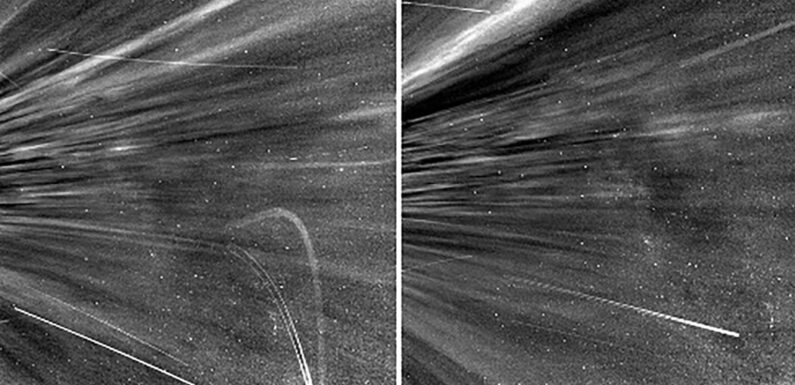
High-speed particles spew out of the sun like water from a shower head, scientists reported on Wednesday.
Data from the Parker Space Probe, a NASA spacecraft that launched in 2018 and is now swooping in to gather readings of the sun’s outer atmosphere, or corona, is providing clues about how the sun generates the solar wind — a million-miles-per-hour stream of electrons, protons and other charged particles rushing outward into the solar system.
The solar wind research ties into a mystery that has long perplexed scientists: Why is the corona, where temperatures soar to millions of degrees, so much hotter than the surface of the sun, which is a relatively cool 10,000 degrees Fahrenheit?
The Parker probe is named after Eugene N. Parker, a University of Chicago astrophysicist who first predicted the existence of the solar wind in 1958.
The sun has an atmosphere of tenuous gases that is dragged downward by gravity while pressure generated by fusion reactions within the sun pushes upward.
Overall, the forces balance so that the sun neither collapses nor blows apart. But the forces do not cancel perfectly everywhere, and Dr. Parker’s calculations show how the sun can act like a leaky balloon.
“If you put enough pressure in the system,” said Stuart Bale, a physicist at the University of California, Berkeley, “the atmosphere can escape. And as it escapes, it’s becoming energized.”
In a paper published on Wednesday in the journal Nature, Dr. Bale, who leads an instrument on the Parker Solar Probe that measures electric and magnetic fields in the solar wind, and his colleagues reported that the streams of solar wind match patterns of hot gases rising and cooler gases falling within the sun. This phenomenon of convection, essentially the same thing that occurs in a thunderstorm, produces up-and-down flows of hydrogen within the sun, and the pattern of flows — like thunderstorms packed next to one another — is known as supergranulation.
The convection of charged particles generates shifting magnetic fields that stretch until they snap and reconnect, releasing energy that contributes to the heating of the corona. That reconnection appears to accelerate the solar wind particles.
Earlier observations of the sun had already indicated that solar wind comes out of what are known as coronal holes, regions where the magnetic field continues far outward into space instead of wrapping around and coming back down at another point on the sun.
Imagine a simple bar magnet, which generates a magnetic field similar in shape to the one that surrounds Earth. At the poles, the magnetic fields go straight up and down; those are the coronal holes.
During the sun’s quiet periods — solar activity varies on an 11-year cycle, from comparatively calm to hyperactive — the sun’s magnetic field possesses this bar magnet configuration. When the Parker spacecraft launched, the sun was near its minimum.
But as the sun approaches the maximum of its cycle, when the magnetic field is in the throes of reversing direction, the structure of the field becomes more complex, and more coronal holes appear.
The Parker spacecraft’s instruments detected that the solar wind was not uniform over coronal holes. Instead, the particles emerged in “microstreams,” like jets from a shower head.
The space probe’s sensors “started seeing that the solar wind had a huge amount of structure,” said James Drake, a professor of physics at the University of Maryland and another author of the Nature paper.
The periodic pattern of the microstreams matched that of the supergranulation, suggesting that magnetic reconnection near the sun’s surface plays a key role in the acceleration of the particles.
“I could figure out all the characteristics of reconnection,” Dr. Drake said. “I could figure out how much heating was going on. And once we figured out how much heating, I found out it was enough to power the wind.”
He added, “We didn’t have this before at all.”
Gary Zank, director of the Center for Space Plasma and Aeronomic Research at the University of Alabama in Huntsville, said the new results were “one crucial and important step in answering the puzzle of why the solar corona is a million degrees more hot compared to its very relatively cold surface.” Dr. Zank was not involved in the research, but he served as one of the scientists who reviewed the paper for Nature editors.
“It basically says, Here is the mechanism by which we can start to understand how that transfer of energy takes place,” Dr. Zank said.
Kenneth Chang has been at The Times since 2000, writing about physics, geology, chemistry, and the planets. Before becoming a science writer, he was a graduate student whose research involved the control of chaos. @kchangnyt
Source: Read Full Article
